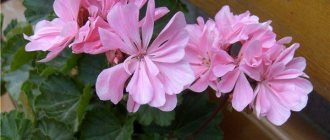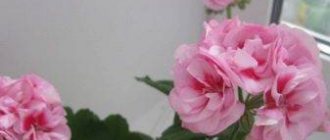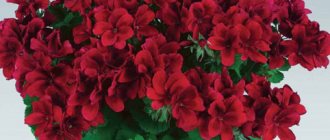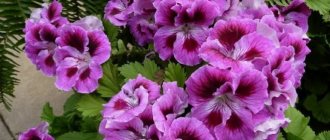Description and characteristics of cultivation
Interestingly, among all the variety of varieties, it is dwarf geranium that is becoming increasingly popular. It has many advantages. For example, such a plant will take its rightful place on the windowsill and fit perfectly into any of your flower collections.
It is grown in a compact pot, since the flower is very miniature. Nevertheless, its small dimensions do not prevent it from blooming magnificently. Another important advantage of this group of geraniums is that formative pruning of such a flower specimen is not necessary at all.
Caring for dwarf pelargonium varieties at home is not too labor-intensive; even a beginner can handle it. However, take some recommendations into account so as not to harm your indoor flowers. For example, like most geraniums, dwarf pelargonium does not like waterlogged soil - it will cause the rhizome to rot before you even blink an eye. That's why remember two things:
- The plant substrate should be moistened in moderation;
- The soil must contain sand or vermiculite. Such components are useful because they absorb excess moisture, and you do not have to correct the consequences of waterlogging the soil.
You will certainly be able to care for low-growing varieties of pelargonium. Over time, many gardeners begin to expand their collection of dwarf geraniums. This can be done easily and at home, no extra costs will be required.
How are these flowers propagated? It is best to start this procedure at the end of February or early March. It is during this period that the plant gradually comes to its senses after wintering, and its vital processes are activated. First of all, cut the cutting with two internodes, and then dry it thoroughly.
The next stage is planting in nutrient soil. It is not recommended to cover the top of the cutting with glass or film - this will only create an excessively humid environment for the geranium, which can have a detrimental effect on it. Miniature cuttings of pelargonium will very quickly take root in a new place. The main thing is to place the pot with the shoots in a well-lit place. Under favorable conditions, within a month you will receive a fully rooted plant.
Of course, you can’t do without transplanting homemade miniature geraniums. This procedure is not performed very often. If you notice that the flower has grown sufficiently, and, most likely, there is no longer enough space for the rhizome in the mini-pot, you can place it in a slightly larger pot. But don’t overdo it: if you plant a plant in a flowerpot that is too large, it may simply die, because the root system will not fill the bottom of the container, and without this the flower will not begin to develop.
In order for pelargonium varieties Dovepoint or pelargonium Barnstondale to delight you with its lush and long-lasting flowering, you need to take care of this yourself. You can't do without feeding. Nutrient mixtures can be added to the substrate a month after planting the plant in its permanent place.
Purchase either universal nutritional formulations or special fertilizers for homemade geraniums. You should not neglect feeding the flowers, since if there is a deficiency of organic and mineral substances in the soil, the plant may suffer from chlorosis or blackleg (fungal disease).
The best varieties
There are more and more new varieties of pelargonium. That is why it is worth considering the most remarkable specimens. Only this way can you make an informed choice and purchase plants that will certainly decorate your home. Among the popular dwarf species of pelargonium, the following varieties are distinguished:
- Madame Maleron. If all previous varieties of pelargonium were distinguished by the presence of bright inflorescences, then this variety does not bloom at all. Its main advantage is its beautiful dark green leaves with a light border;
- Pac Harmony. The flowers of this plant are quite large, semi-double, and have a rich pink color;
- Only Joss. The key advantage of this specimen is the presence of bright, berry-red flowers. There is a slight light inclusion in the center of the bud;
Why is the flower considered Her Majesty among geraniums?
These are noticeable spreading plants, growing up to 50 cm.
They delight gardeners with large (up to 7 cm in diameter, or even larger) flowers of various colors, both plain (albeit with dark stripes or spots running along the veins) and variegated. Often they also have corrugated or wavy edges of the petals (the so-called double flowers).
The leaves of these flowers resemble maple leaves, but smaller and more “toothed.”
If other geraniums (say, zonal) can bloom all year without ceasing, then Her Majesty deigns to bloom for only 3-4 months. And even then, if the flower is not given winter rest, the flowers may not wait.
The best varieties of royal pelargoniums
There are a lot of them these days—more than one hundred. Therefore, you can consider this list of the best as my IMHO... But in our store they are the most popular ones. Looking at the photo, it’s not hard to guess why!
Ann Hoystead. Medium-high variety (grows up to 40 cm). It is distinguished by red-burgundy petals with a deep dark middle part and a light edge.
Askham Fringed Aztec. An even shorter (up to 30 cm) variety that has white flowers with “cut” petals at the tips and pink patterns in the center.
Black Prince. A variety with deep burgundy flowers, each petal of which is bordered by a contrasting light stripe. Grows up to 40 cm.
Bushfire. It has scarlet flowers, in the depths of which there are dark spots. The height of the bushes is up to half a meter.
Carisbrooke. A relatively tall (up to 45 cm) variety with pink flowers. Terry petals are decorated with crimson stripes and strokes.
Georgina Blythe. Another red variety, this time low-growing (no higher than 35 cm). The center of the flowers is white, the petals are slightly terry.
Joy. Joy differs from the previous variety in that it has a greenish rather than white center and the absence of dark spots and veins. It also has slightly double, red petals (but no longer with orange, but rather with a pinkish tint). The bushes of the variety are tall - up to 45 cm, but the flowers are small - a maximum of 4.5 cm in diameter.
Lavender Grand Slam. Terry pink variety with burgundy centers. It grows up to 40 cm, standard for royal pelargonium.
Lord Bute. The variety is somewhat reminiscent of Black Prince, but its flowers are even darker - deep wine color, edged with a dark pink stripe. The bush has a height of 45 cm. This variety cannot be called terry, but still the petals are slightly curved at the edges.
Margaret Stoley. This is one of the most variegated varieties. The red petals have spots, veins, and borders - in addition, their shape is also terry. The advantage of Margaret Stoli is that despite the very compact size of the bush (it grows up to 30 cm), it is decorated with relatively large flowers - their diameter reaches 6 cm.
Morwenna. This is the darkest of the varieties presented in this “top”. Morwenna's petals are burgundy, iridescent almost black, and are also wavy along the edges. And, although the bush of this variety is small, its flowers are very large.
Rimfire. These wavy flowers seem to bring together all the shades of red. In addition, they are also quite large.
White Glory. Tall (45 cm) bushes are decorated with “fluffy” white flowers. They are also giants among pelargoniums - they reach 7.5 cm in diameter.
The varieties Candy Flowers or Candy Flowers (originally Candy Flowers) deserve special attention. They are decorated with two-color flowers with characteristic spots that do not appear on every petal.
In this “series” there are several varieties, the names of which reflect the main shade of the petals:
- Candy Flowers Bicolor (pink flowers, as in the photo above),
- Bright Red (cherry flowers with black spots on the petals),
- Dark Red (velvety dark red flowers with almost black spots - interestingly, the reverse side of the flowers has a lighter shade).
Important! Almost all varietal pelargonium flowers of “royal blood” do not have that characteristic aroma that not everyone can stand (that is, simply unpleasant). Therefore, they can be safely placed in the living room and even the bedroom.
Rookley pelargonium
At the moment, all varieties are in stock. The price of a rooted plant, with an excellent root system that can withstand shipping, is 250 rubles, regardless of the variety. On this page, some of the photos are taken from the Internet.
1.
The flower is large, simple, with slightly corrugated two-color petals, the upper petals are velvet, very dark cherry color, with a velvet red border, behind the border there is another pink border along the very edge of the petals, in the center of the petals there are purple flashes with a white mesh pattern
2.
Huge salmon-colored flowers with wavy edges and a burgundy spot on the upper petals.
3.
Huge red-ruby flowers, in the middle of the petal there is a large dark burgundy spot with dark strokes at the base of the petals, small silver spots along the edge
4.
Lilac-lavender flowers: large, bright and slightly ruffled
Askham Fringed aztec
5.
A very contrasting variety. The main color is white. In the center of each petal, a bright crimson spot is surrounded by a red openwork mesh. The petals have a beautiful jagged edge.
6.
Very large white flowers in the center of each petal there is a bright, dark red large spot surrounded by bright pink. Everything is completed with a black cherry openwork mesh. Very contrasting!
7.
K dwarf royal pelargonium. Synonym 'Beronmunster'. Fibrex. 1988. White shade with crimson flashes on the petals.
8.
Synonym: Brown's Butterfly. Under favorable conditions, a lighter pattern similar to a butterfly wing appears on the petals.
9.
Synonym: Brown's Butterfly. Under favorable conditions, a lighter pattern similar to a butterfly wing appears on the petals.
10.
Large, equal-petaled white flowers with large bright crimson spots on each petal. The edges of the petals are slightly wavy. Abundant and long flowering.
11.
Beautiful wavy bluish-purple flowers, a compact plant with rich, long-lasting blooms.
12.
A large wavy and notched flower, deep red in color, with a black spot in the center of each petal. The wavy edge is accented with fuchsia fringe. A very beautiful variety.
13.
ANGEL. The upper petals of the flower are dark purple, the lower petals are light purple. Has a slightly orchid shape.
14.
Very large, beautiful white flowers with wavy petals. The upper petals have a finger-like blush of red, surrounded by pink lacy veining. The lower petals have a soft pink finger blush. A very gentle variety.
15.
Oh huge flowers. The upper petals are slightly pink, have an orange-red spot and cherry-red veins that extend from the base of the flower.
16.
The upper petals are rusty red with a deep burgundy tint and a slight black coating. There is more dark purple towards the center of the flower. The leaves are green and large. Develops well, quite compact variety.
17.
There is a pink blush on the white petals of the flower. The center is white. The edge of the petals is very wavy. The variety is easy to form. Blooms profusely.
18.
A very large, dazzling white semi-double and fringed flower, which is very rare. An unusually beautiful variety!
How to care for such a flower
- Lighting. It should be bright, but diffused (shade the flower at least on a hot summer afternoon). If the plant grows in the shade, it will stretch out unattractively, “looking” for light, and, moreover, it may drop its buds, or even refuse to set them at all.
- Temperature. Royal geranium loves warmth. You can keep it on a closed balcony, but you can’t take it out into the open or into the garden, since the flower is very sensitive to drafts.
- Watering. As soon as the top of the soil dries out (in summer), pour plenty of water into the pot. Although pelargonium will not die if it “dries out” a little, it likes frequent watering.
- Spraying. If the air is dry, it is better to irrigate the flower with a spray bottle. But so that after this the sun does not hit the leaves, otherwise it will end in a burn (dew droplets dangerously refract the light, increasing its intensity). So spray your pet in the evening. If you do not spray the flower in the heat, aphids and other pests may grow on the leaves, which are difficult to remove.
- Circumcision. As with petunias, dried leaves and faded flowers must be cut off from pelargonium all the time.
- Nutrition. This is a necessity if you expect a “cap” flowering of your varietal beauty. A mineral complex fertilizer for decorative flowerpots will suit you. Apply it in spring and summer.
Winter dormancy is the key to flowering pelargonium
The plant should be kept at a low temperature (from 10 to 12, maximum 15 degrees).
Since geranium almost does not grow in the cold, which means it uses less water, reduce watering and pour very little water into the soil.
But take care of the lighting of the flower - keep it in the same window, and if it seems to you that there is not enough light for the plant, move the geranium to the room where the light bulb is most often on. Additional illumination with a phytolamp may also be relevant.
Fertilizers should be completely abandoned, not given in autumn and winter.
Planting seeds
This event looks like this:
- first of all, the seeds must be soaked for 2 hours before sowing;
- then you need to distribute them in the prepared greenhouse at a distance of at least 2 cm from each other;
- after this, you need to cover the crops with a small layer of loose, moist soil;
- The last stage is spraying the soil with a spray bottle.
The greenhouse is kept at a temperature of no more than +25 degrees and must be ventilated. The first shoots will appear in 5-7 days.
The shoots are rooted in water. The process looks like this step by step:
- you need to take an opaque container;
- then prepare a solution for seedlings: take “Kornevin” powder on the tip of a knife for 100 g of water;
- the plants are kept in the preparation for a day;
- Pelargoniums are placed in a glass with settled water and two tablets of activated carbon until roots form.
Why is the flower considered Her Majesty among geraniums?
These are noticeable spreading plants, growing up to 50 cm.
They delight gardeners with large (up to 7 cm in diameter, or even larger) flowers of various colors, both plain (albeit with dark stripes or spots running along the veins) and variegated. Often they also have corrugated or wavy edges of the petals (the so-called double flowers).
The leaves of these flowers resemble maple leaves, but smaller and more “toothed.”
If other geraniums (say, zonal) can bloom all year without ceasing, then Her Majesty deigns to bloom for only 3-4 months. And even then, if the flower is not given winter rest, the flowers may not wait.
The best varieties of royal pelargoniums
There are a lot of them these days—more than one hundred. Therefore, you can consider this list of the best as my IMHO... But in our store they are the most popular ones. Looking at the photo, it’s not hard to guess why!
Ann Hoystead. Medium-high variety (grows up to 40 cm). It is distinguished by red-burgundy petals with a deep dark middle part and a light edge.
Askham Fringed Aztec. An even shorter (up to 30 cm) variety that has white flowers with “cut” petals at the tips and pink patterns in the center.
Black Prince. A variety with deep burgundy flowers, each petal of which is bordered by a contrasting light stripe. Grows up to 40 cm.
Bushfire. It has scarlet flowers, in the depths of which there are dark spots. The height of the bushes is up to half a meter.
Carisbrooke. A relatively tall (up to 45 cm) variety with pink flowers. Terry petals are decorated with crimson stripes and strokes.
Georgina Blythe. Another red variety, this time low-growing (no higher than 35 cm). The center of the flowers is white, the petals are slightly terry.
Joy. Joy differs from the previous variety in that it has a greenish rather than white center and the absence of dark spots and veins. It also has slightly double, red petals (but no longer with orange, but rather with a pinkish tint). The bushes of the variety are tall - up to 45 cm, but the flowers are small - a maximum of 4.5 cm in diameter.
Lavender Grand Slam. Terry pink variety with burgundy centers. It grows up to 40 cm, standard for royal pelargonium.
Lord Bute. The variety is somewhat reminiscent of Black Prince, but its flowers are even darker - deep wine color, edged with a dark pink stripe. The bush has a height of 45 cm. This variety cannot be called terry, but still the petals are slightly curved at the edges.
Margaret Stoley. This is one of the most variegated varieties. The red petals have spots, veins, and borders - in addition, their shape is also terry. The advantage of Margaret Stoli is that despite the very compact size of the bush (it grows up to 30 cm), it is decorated with relatively large flowers - their diameter reaches 6 cm.
Morwenna. This is the darkest of the varieties presented in this “top”. Morwenna's petals are burgundy, iridescent almost black, and are also wavy along the edges. And, although the bush of this variety is small, its flowers are very large.
Rimfire. These wavy flowers seem to bring together all the shades of red. In addition, they are also quite large.
White Glory. Tall (45 cm) bushes are decorated with “fluffy” white flowers. They are also giants among pelargoniums - they reach 7.5 cm in diameter.
The varieties Candy Flowers or Candy Flowers (originally Candy Flowers) deserve special attention. They are decorated with two-color flowers with characteristic spots that do not appear on every petal.
In this “series” there are several varieties, the names of which reflect the main shade of the petals:
- Candy Flowers Bicolor (pink flowers, as in the photo above),
- Bright Red (cherry flowers with black spots on the petals),
- Dark Red (velvety dark red flowers with almost black spots - interestingly, the reverse side of the flowers has a lighter shade).
Important! Almost all varietal pelargonium flowers of “royal blood” do not have that characteristic aroma that not everyone can stand (that is, simply unpleasant). Therefore, they can be safely placed in the living room and even the bedroom.
How to care for such a flower
- Lighting. It should be bright, but diffused (shade the flower at least on a hot summer afternoon). If the plant grows in the shade, it will stretch out unattractively, “looking” for light, and, moreover, it may drop its buds, or even refuse to set them at all.
- Temperature. Royal geranium loves warmth. You can keep it on a closed balcony, but you can’t take it out into the open or into the garden, since the flower is very sensitive to drafts.
- Watering. As soon as the top of the soil dries out (in summer), pour plenty of water into the pot. Although pelargonium will not die if it “dries out” a little, it likes frequent watering.
- Spraying. If the air is dry, it is better to irrigate the flower with a spray bottle. But so that after this the sun does not hit the leaves, otherwise it will end in a burn (dew droplets dangerously refract the light, increasing its intensity). So spray your pet in the evening. If you do not spray the flower in the heat, aphids and other pests may grow on the leaves, which are difficult to remove.
- Circumcision. As with petunias, dried leaves and faded flowers must be cut off from pelargonium all the time.
- Nutrition. This is a necessity if you expect a “cap” flowering of your varietal beauty. A mineral complex fertilizer for decorative flowerpots will suit you. Apply it in spring and summer.
Winter dormancy is the key to flowering pelargonium
The plant should be kept at a low temperature (from 10 to 12, maximum 15 degrees).
Since geranium almost does not grow in the cold, which means it uses less water, reduce watering and pour very little water into the soil.
But take care of the lighting of the flower - keep it in the same window, and if it seems to you that there is not enough light for the plant, move the geranium to the room where the light bulb is most often on. Additional illumination with a phytolamp may also be relevant.
Fertilizers should be completely abandoned, not given in autumn and winter.
What you need to know about care
Caring for Salmon pelargoniums involves implementing standard agrotechnical practices.
Watering
Pelargonium Salmon needs moderate watering. It is advisable to water 1-2 times a week. Excess moisture negatively affects the plant. For irrigation you need to use soft and settled water. If water gets on the leaves and petals, it can cause burns.
Feeding
During the flowering period, plants prefer phosphorus-potassium fertilizers. You can use liquid fertilizers or add a long-acting dry granular fertilizer to the soil when planting. In this case, you will not have to worry about regularly feeding your flowers.
When purchasing fertilizer, pay attention to the content of microelements in the mixture. The following are especially important for the plant:
- magnesium;
- zinc;
- iron;
- iodine.
Plants require nitrogen in minimal quantities when buds have not yet formed on the bushes.
Temperature
In summer, Salmon prefers an air temperature of no more than +25 degrees. In winter, the best conditions are a cool, draft-free room with a temperature of +18 to +15 degrees.
Trimming
In order for the plant to be beautiful and lush, it is necessary to give it the desired shape by pinching the tops of young shoots or cuttings.
In the spring, at the beginning of March, young healthy shoots with several leaves more than 5-6 cm long are pruned.











